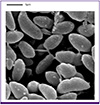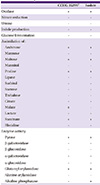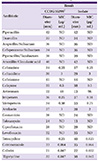1. Kämpfer P, Lodders N, Martin K, Falsen E. 2000, with an emended description of the genus and inclusion of all species of the genus
Naxibacter as new combinations, and proposal of
Massilia consociata sp. nov. Int J Syst Evol Microbiol. 2011; 61:1528–1533.

2. Du Y, Yu X, Wang G.
Massilia tieshanensis sp. nov., isolated from mining soil. Int J Syst Evol Microbiol. 2012; 62:2356–2362.
3. Lindquist D, Murrill D, Burran WP, Winans G, Janda JM, Probert W. Characteristics of
Massilia timonae and
Massilia timonae-like isolates from human patients, with an emended description of the species. J Clin Microbiol. 2003; 41:192–196.

4. Clinical and Laboratory Standards Institute (CLSI). Performance standards for antimicrobial susceptibility testing: 21st informational supplement. CLSI document M100-S21. Wayne, PA: CLSI;2011.
5. La Scola B, Birtles RJ, Mallet MN, Raoult D.
Massilia timonae gen. nov., sp. nov., isolated from blood of an immunocompromised patient with cerebellar lesions. J Clin Microbiol. 1998; 36:2847–2852.

6. Xu P, Li WJ, Tang SK, Zhang YQ, Chen GZ, Chen HH, Xu LH, Jiang CL.
Naxibacter alkalitolerans gen. nov., sp. nov., a novel member of the family ‘
Oxalobacteraceae’ isolated from China. Int J Syst Evol Microbiol. 2005; 55:1149–1153.

7. Kämpfer P, Falsen E, Busse HJ.
Naxibacter varians sp. nov. and Naxibacter haematophilus sp. nov., and emended description of the genus Naxibacter
. Int J Syst Evol Microbiol. 2008; 58:1680–1684.
8. Weon HY, Yoo SH, Kim SJ, Kim YS, Anandham R, Kwon SW.
Massilia jejuensis sp. nov. and
Naxibacter suwonensis sp. nov., isolated from air samples. Int J Syst Evol Microbiol. 2010; 60:1938–1943.

9. Kim J.
Massilia kyonggiensis sp. nov., isolated from forest soil in Korea. J Microbiol. 2014; 52:378–383.
10. Shen L, Liu Y, Wang N, Yao T, Jiao N, Liu H, Zhou Y, Xu B, Liu X.
Massilia yuzhufengensis sp. nov., isolated from an ice core. Int J Syst Evol Microbiol. 2013; 63:1285–1290.
11. Luo X, Xie Q, Wang J, Pang H, Fan J, Zhang J.
Massilia lurida sp. nov., isolated from soil. Int J Syst Evol Microbiol. 2013; 63:2118–2123.
12. Kong BH, Li YH, Liu M, Liu Y, Li CL, Liu L, Yang ZW, Yu R.
Massilia namucuonensis sp. nov., isolated from a soil sample. Int J Syst Evol Microbiol. 2013; 63:352–357.
13. Wang J, Zhang J, Pang H, Zhang Y, Li Y, Fan J.
Massilia flava sp. nov., isolated from soil. Int J Syst Evol Microbiol. 2012; 62:580–585.
14. Kämpfer P, Lodders N, Martin K, Falsen E.
Massilia oculi sp. nov., isolated from a human clinical specimen. Int J Syst Evol Microbiol. 2012; 62:364–369.
15. Weon HY, Kim BY, Hong SB, Jeon YA, Koo BS, Kwon SW, Stackebrandt E.
Massilia niabensis sp. nov. and
Massilia niastensis sp. nov., isolated from air samples. Int J Syst Evol Microbiol. 2009; 59:1656–1660.

16. Zul D, Wanner G, Overmann J.
Massilia brevitalea sp. nov., a novel betaproteobacterium isolated from lysimeter soil. Int J Syst Evol Microbiol. 2008; 58:1245–1251.

17. Weon HY, Kim BY, Son JA, Jang HB, Hong SK, Go SJ, Kwon SW.
Massilia aerilata sp. nov., isolated from an air sample. Int J Syst Evol Microbiol. 2008; 58:1422–1425.
18. Zhang YQ, Li WJ, Zhang KY, Tian XP, Jiang Y, Xu LH, Jiang CL, Lai R.
Massilia dura sp. nov.,
Massilia albidiflava sp. nov.,
Massilia plicata sp. nov. and
Massilia lutea sp. nov., isolated from soils in China. Int J Syst Evol Microbiol. 2006; 56:459–463.

19. Gallego V, Sánchez-Porro C, García MT, Ventosa A.
Massilia aurea sp. nov., isolated from drinking water. Int J Syst Evol Microbiol. 2006; 56:2449–2453.
20. Sintchenko V, Jelfs P, Sharma A, Hicks L, Gilbert GL.
Massilia timonae: an unusual bacterium causing wound infection following surgery. Clin Microbiol Newsl. 2000; 22:149–151.








 PDF
PDF ePub
ePub Citation
Citation Print
Print



 XML Download
XML Download